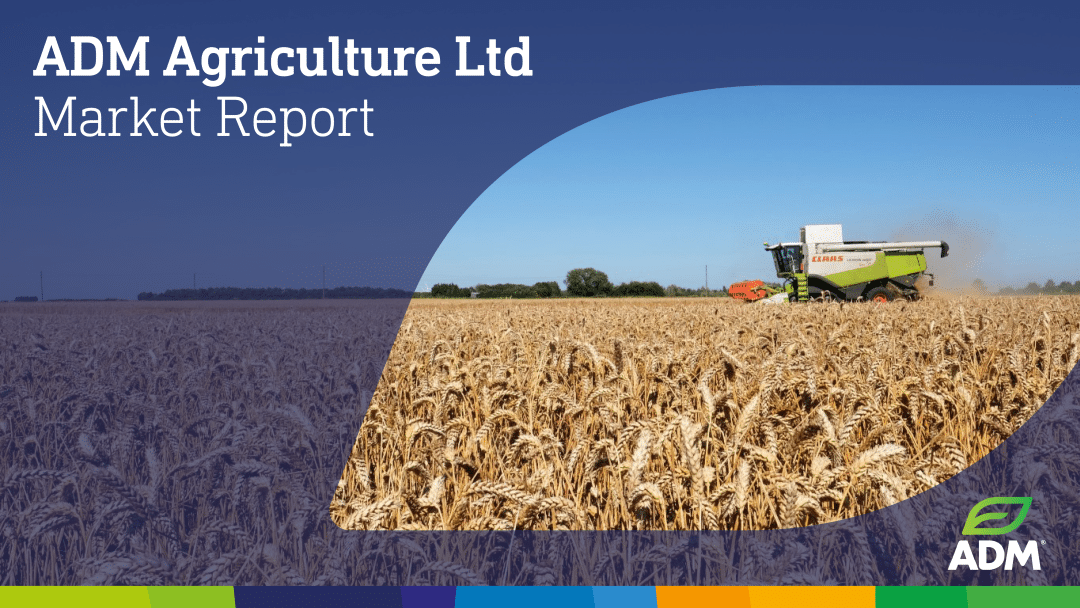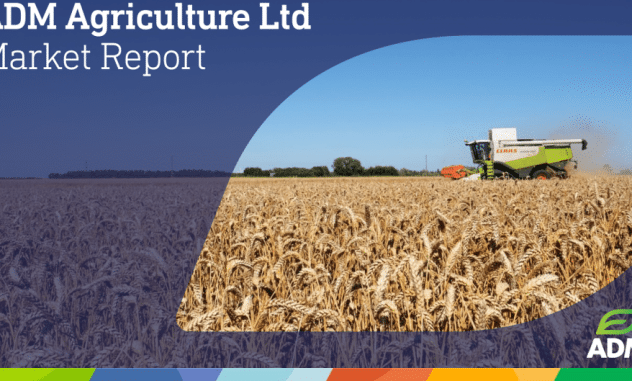WELCOME TO THE ADM AGRICULTURE WEEKLY MARKET REPORT
Wheat
- The US prices have firmed just shy of $5/t w/w, as supportive export numbers and less than favourable weather provide support.
- US wheat exports came in at a seasonal high last week, and the current pace of 36% higher y/y would support an upward revision in the export projection in next month’s WASDE report. While current ratings would still support record corn and bean yields, the expanding drought area sweeping across the US growing regions adds concerns, especially to newly sown winter wheat.
- EU prices have gained just €1.25/t w/w. Adverse weather conditions across much of western Europe are potentially delaying winter crop sowings, and after the problem experienced last season, planting areas are being talked lower than originally envisaged. While the global markets have seen some support surface, European prices remained pressured by the continued exports or aggressively priced Black Sea origin exports, and the slow pace of EU exports, currently seen down 24% y/y at 5.855mln t.
- UK prices have fallen £1.30/t w/w, as the market tries and trade against a soaring UK£. Farmer selling activity remains slow, allowing delivery premiums to stay strong, and with most farmers battling the weather, and trying to get crops sown, the volume of fresh supplies hitting the market remains limited.
- In summary, strong US demand, a weak US$, and global weather have lent support to the global market, albeit weak EU demand and a strong euro is a headwind for the MATIF market. The focus regarding weather and its impact on winter crop sowings, and development, will intensify over the coming weeks, especially within the EU, Russia, and the US, and with China lowering interest rates as a potential stimulus to the market, this could trigger additional fund buying across all commodities.
Malting Barley
- To an even greater degree than feed barley, the malting barley market is extremely slow. Once again, low farmer selling is a key theme, meanwhile, demand remains absent with poor end-user engagement and good nearby coverage. Today, it is tricky to make a friendly argument on malting barley, unless we see a major resurgence in demand ahead of a further wave of farmer selling.
Feed Barley
- For another week low liquidity remains the key theme for the feed barley market. Farmer selling, although picking up, is still sluggish in line with the seasonal trend in this area. Meanwhile, consumer demand is starting to slow down as futures continue to increase, and barley continues to work to close the gap vs. other feed products and trim demand.
- Globally, demand is similarly slow, and two international tenders were passed up this week with corn maintaining better value than feed barley. Nearby coaster demand for EU destinations is nonexistent.
- Given the surplus we have in the country and the lack of demand seen, we maintain the view that feed barley is a compelling sell for growers who have stocks to market, particularly with futures levels trading around the recent highs.
Rapeseed
- CBOT soybean prices struggled to break overhead resistance yesterday and lacked anything new to push them higher in the short term. Fund short covering followed through into yesterday’s session which lent support.
- Weather in the U.S. still shows rain for the next week with a tropical storm moving through in the Gulf before the weekend. U.S. harvest progress fell behind the average estimate of 18% to be only 13% as of September 22nd. Crop ratings were unchanged.
- Chinese buying interest picked up in recent days, with sales announced to China and some unknown buyers. Rumours of further Chinese purchases yesterday, but we lacked any confirmation from the USDA during yesterday’s session. This could be reported at the same time as today’s export sales update.
- Hurricane Helene is expected to hit land today/tomorrow, bringing wet weather. As a result, we may see some harvest delays.
- South America overnight, excluding BAGE, estimates the 2024/25 soybean crop at 52mln t, compared to the USDA’s projection of 51mln t. LSEG estimates Brazil’s soybean crop at 165mln t, while the USDA projects 169mln t (CONAB at 166.3mln t).
- Brazilian soybean exports were reported at 5.82mln t in September which fell slightly short of expectations. Rains are now appearing in the 6-10 day forecast across large parts of Brazil, although heavy in some regions, central parts levels may fall short of desired levels needed to help replenish soil moisture levels. The impact of planting delays would push China back to U.S. supplies until Brazilian supplies were available.
- Energy markets saw oil dip back of recent highs to close below $70. Despite the EIA reporting a large draw on stock in recent weeks. However, uncertainty over China’s economy, despite recent intervention, is weighing on prices. Palm closed higher; soy oil closed higher following the support from the Farmer First Fuel Incentive Act which would mean importing less feedstock oils for the U.S. fuel market.
- Canola and MATIF rapeseed values found support from firmer U.S. markets in the last week. Port strikes in Vancouver over the next few days will have lent support. MATIF rapeseed broke through levels we have not seen since July. Unfortunately for the UK market, sterling still trades way above the levels we saw in July which impacts farm gate prices.
Oats
- The oat market in Europe continues to see falling prices with strong supplies from Scandinavia continuing to weigh on the market.
- Demand is picking up with consumers looking to cover sales to retail customers which could see prices stabilise.
- Feed oats are become more available in both Scandinavia and the Baltics, with some areas seeing low specific weights and or high mycotoxins.
- Demand for feed oats remains challenging with further low prices needed to attract demand in both western, central, and southern Europe.
- Here in the UK, harvest is largely complete, with only some parts of Scotland reporting oats still in the field. The quality is generally reported to be exceptional with many samples testing in excess of 54kg/hl and sub 3% screenings (2mm).
- Prices in the UK continue to fall given the large volumes of oats needing to find a home for Q4 and Q1 movement. Buyers know this and so are rightly bidding prices lower in order to ensure they are competitive against other oat product manufacturers in Europe.
- Bottom line, prices for oats could still come lower as countries try to remain competitive in order to market their exportable surplus, however a pickup in demand could stem the downward price trajectory.
Pulses
- We have seen further beans cut across the northern half of the UK this week, although very few samples have made their way through the lab yet. Anecdotally, the beans sound like they are coming off similarly to what we saw in the southern half of the UK, namely low admix and low insect damage, however, they are certainly damper. Overall, a quiet week on the markets, with prices relatively unchanged, although there is pressure on nearby beans looking for a home, so if you can hold on to them for a couple of months, it is certainly worth doing so. The first Baltic vessels are arriving in Egypt, and the quality looks reasonable, especially compared to some of the doom-mongering that was doing the rounds early on.
- In the week ahead, we will likely see the northern harvest make some good headway, although there are still plenty of reports of growers only starting to spray beans off now, fearful that the ambient temperatures are not high enough to turn the crop. One thing that could put paid to all of this is the weather. With the end of September rapidly approaching, we are looking at significant rainfall across the southern half of the UK, and not much less across the northern half. Unsurprisingly, this is also bringing cooler-than-normal temperatures, so we will likely see a testing final phase. The Baltic is seeing similar levels of rainfall, albeit with slightly above-average temperatures for this time of year.
- UK beans continue to look better in terms of quality than we have seen in recent years, although the Baltic still does appear to have the edge. Despite this, there is a possibility of additional premiums for growers with good-quality beans. With this in mind, it is very much in your interest to keep talking to your farm trader and pushing samples across if they look like they have potential, as we may be able to upgrade them for you and pay an additional premium if they hit spec. Feed beans are edging slightly closer to featuring with recent pops in the rapemeal market, but still have some way to go, needing to give c. £10/mt relative to other commodities. Feed is only likely to come under further pressure and be squeezed lower, especially if there is a larger proportion of feed coming down from the Baltic.
- Turning to the currency markets, the short-term outlook for GBPUSD and GBPEUR is influenced by ongoing inflation concerns, BoE interest rate expectations, and geopolitical uncertainty. GBPUSD could face downward pressure due to a stronger USD, while GBPEUR remains more stable but vulnerable to an economic divergence between the UK and Eurozone. Both pairs remain sensitive to central bank policy shifts and economic data. Remember, crudely, strong GBP = cheaper imports, but weaker exports/weak GBP = weaker imports, but more aggressive exports.
- While the weather is wet and wild, fieldwork is never far away, and the pulse drilling season is approaching for winter crops. It is worth making time to talk to your farm trading representative during the weather stoppages we are likely to see over the coming days, as they will be more than happy to advise you on what contracts we have available. With a combination of great marketing options, various seed stocks ready to go, and a portfolio of cost-effective inputs, such as P-Grow and FibroPhos that can help push your yield potential, they are ready and happy to help. We are buyers across a wide spread of homes nationally and can offer you competitive origination markets, plus the opportunity to upgrade any crops that may be fit to human consumption pulses to be processed in one of the most advanced pulse processing plants in the UK and Europe, all whilst earning an additional premium for your crops.
- Finally, the ever-present PGRO plug to those eligible to be members. If you are not already signed up to the PGRO mailing list, you can sign up here where levy payers can access all sorts of advice and support, tapping into their extensive knowledge bank on all things pulses for free! The PGRO is a unique organisation within the UK, and if you are paying for it, you may as well use it!
Seed
- With Group 1 varieties now being virtually impossible to find, we are pleased to offer KWS Palladium & RGT Goldfinch, both Group 2 varieties with a milling buyback for harvest 2025. In the Group 3 market, we have an extremely limited amount of Bamford to offer, again with a buyback for harvest 2025. Bamford allows growing a Group 3 soft wheat with premium yields that compare to the best of the hard Group 4’s.
- Looking ahead, spring barleys are creating early interest. We are pleased to offer Laureate, Tennyson, RGT Planet, RGT Asteroid, and limited amounts of Belter. For further information on varieties and buybacks available, please contact your farm trader.
- If you are looking to sow a grass ley this autumn, we have a range of mixtures available, from short to longer term, agriculture to amenity. Contact your ADM Agriculture farm trader for more information.
Fertiliser
- Urea market spot prices rose globally this week in response to fresh Indian buying tenders coming earlier than expected, prompting spates of Egyptian cargoes at higher price levels, some $35 a tonne off the floor a month ago. The continuation of restricted Chinese exports is also helping to maintain and support these new higher levels.
- Ammonia production plant outages and maintenance have reduced spot availability in Europe and Middle East regions, applying upside pressure on price levels. Europe has seen the highest prices, though buyers are yet to rise to these levels, governed by mixed downstream returns. Outlooks to get tighter with further supply chain disruptions, while the global balance is expected to broaden at the end of the year.
- Phosphates spot prices revised upwards, centred around India’s buyers taking 215,000t from few buying options. The consensus is DAP prices are nearing their peak, as Indian price hikes begin to slow down. Elsewhere, prices remain relatively stable as restrictive supply is balanced by weakened demand.
- Potash, MOP prices were mostly flat as sluggish demand for MOP in the US, Brazil, and Europe is likely to persist in the next few months.
- Farmers in Western Europe are finding less available storage on farm. Holding grain in the hope of higher prices, possible knock-on effects include a shorter, more competitive nitrogen buying window for spring application.
| £/€ | £/$ | €/$ |
|---|---|---|
| 1.1995 | 1.3375 | 1.1150 |
| Feed Barley £ | Wheat £ | Beans £ | Oilseed Rape £ | |
|---|---|---|---|---|
| Nov 24 | 152-167 | 177-192 | 220-235 | 390-395 |
NB: Prices quoted are indicative only at the time of going to press and subject to location and quality.
“Although ADM Agriculture take steps to ensure the validity of all information contained within the ADM Agriculture Market Report, it makes no warranty as to the accuracy or completeness of such information. ADM Agriculture will have no liability or responsibility for the information or any action or failure to act based upon such information.”
ADM Agriculture cannot accept liability arising from errors or omissions in this publication.
ADM Agriculture trade under AIC contracts which incorporate the arbitration clause.
Terms and Conditions of Purchase.
On every occasion, without exception, grain and pulses will be bought by incorporating by reference the terms & conditions of the AIC No.1 Grain and Peas or Beans contract applicable on the date of the transaction. Also, we will always, and without exception, buy oilseed rape and linseed by incorporating by reference the terms & conditions of the respective terms of the FOSFA 26A and the FOSFA 9A contracts applicable on the date of the transaction. It is a condition of all such transactions that the seller is deemed to know, accept and understand the terms and conditions of each of the above contracts.



